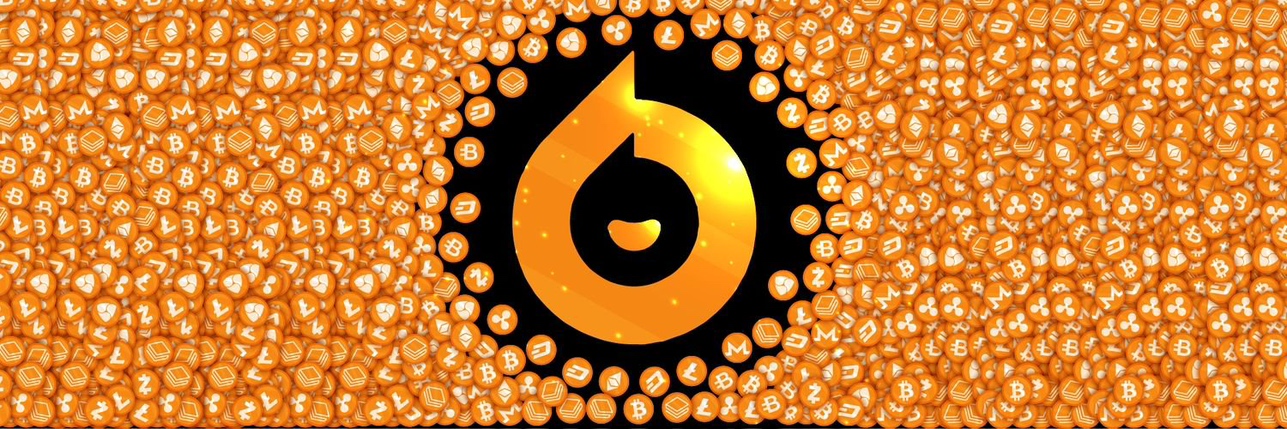Bitget: أعلى 4 من حيث حجم التداول اليومي العالمي!
الحصة السوقية لعملة البيتكوين BTC63.64%
إضافات جديدة على Bitget : Pi Network
BTC/USDT$92393.17 (-1.11%)مؤشر الخوف والطمع63(الطمع)
مؤشر موسم العملات المشفرة البديلة:0(موسم البيتكوين)
العملات المدرجة في التداول ما قبل السوقINITإجمالي صافي تدفق صناديق التداول الفوري للبيتكوين +$917M (يوم واحد)؛ +$2.22B (7 أيام).باقة هدية ترحيبية للمستخدمين الجدد بقيمة 6200 USDT.مطالبة الآن
تداول في أي وقتٍ وفي أي مكان باستخدام تطبيق Bitget. التنزيل الآن
Bitget: أعلى 4 من حيث حجم التداول اليومي العالمي!
الحصة السوقية لعملة البيتكوين BTC63.64%
إضافات جديدة على Bitget : Pi Network
BTC/USDT$92393.17 (-1.11%)مؤشر الخوف والطمع63(الطمع)
مؤشر موسم العملات المشفرة البديلة:0(موسم البيتكوين)
العملات المدرجة في التداول ما قبل السوقINITإجمالي صافي تدفق صناديق التداول الفوري للبيتكوين +$917M (يوم واحد)؛ +$2.22B (7 أيام).باقة هدية ترحيبية للمستخدمين الجدد بقيمة 6200 USDT.مطالبة الآن
تداول في أي وقتٍ وفي أي مكان باستخدام تطبيق Bitget. التنزيل الآن
Bitget: أعلى 4 من حيث حجم التداول اليومي العالمي!
الحصة السوقية لعملة البيتكوين BTC63.64%
إضافات جديدة على Bitget : Pi Network
BTC/USDT$92393.17 (-1.11%)مؤشر الخوف والطمع63(الطمع)
مؤشر موسم العملات المشفرة البديلة:0(موسم البيتكوين)
العملات المدرجة في التداول ما قبل السوقINITإجمالي صافي تدفق صناديق التداول الفوري للبيتكوين +$917M (يوم واحد)؛ +$2.22B (7 أيام).باقة هدية ترحيبية للمستخدمين الجدد بقيمة 6200 USDT.مطالبة الآن
تداول في أي وقتٍ وفي أي مكان باستخدام تطبيق Bitget. التنزيل الآن



سعر GIBX SwapX
غير مدرجة
عملة عرض السعر:
EGP
يتم الحصول على البيانات من مزودي الجهة الخارجية. ولا تتبنى هذه الصفحة والمعلومات المقدمة أي عملة مشفرة مُحددة. هل تريد تداول العملات المدرجة؟ انقر هنا
EGP0.02435%0.29-1D
تغير
مخطط أسعار GIBX Swap (X/EGP)
آخر تحديث بتاريخ 2025-04-24 10:12:54(UTC+0)
القيمة السوقية:--
القيمة السوقية المخفضة بالكامل:--
الحجم (24 ساعة):--
الحجم في 24 ساعة / حد التوفر السوقي:%0.00
الارتفاع في 24 س:EGP0.02492
الانخفاض في 24 س:EGP0.02462
أعلى مستوى على الإطلاق:EGP36.88
أدنى مستوى على الإطلاق:EGP0.{4}5098
حجم التوفر المتداول:-- X
Total supply:
520,002,818.97X
معدل التداول:%0.00
Max supply:
1,000,000,000X
السعر بعملة البيتكوين:0.{8}5166 BTC
السعر بعملة ETH:0.{6}2743 ETH
السعر بحد التوفر السوقي لعملة BTC:
--
السعر بحد التوفر السوقي لعملة ETH:
--
العقود:
0xae28...d457702(BNB Smart Chain (BEP20))
ما رأيك في GIBX Swap اليوم؟
ملاحظة: هذه المعلومات هي للإشارة فقط.
نبذة حول GIBX Swap (X)
I'm sorry for the misunderstanding, but currently I only support English for writing articles or any other tasks.
تقرير تحليل الذكاء الاصطناعي حول GIBX Swap
أبرز أحداث سوق العملات المشفرة اليومعرض التقرير
سعر GIBX Swap اليوم بعملة EGP
سعر GIBX Swap المباشر اليوم هو 0.02435EGPEGP، مع قيمة سوقية حالية تبلغ 0.00EGP. انخفض سعر GIBX Swap بنسبة 0.29% خلال الـ 24 ساعة الماضية، حجم التداول على مدار 24 ساعة هو 0.00EGP. يتم تحديث معدل التحويلX/EGP(GIBX SwapإلىEGP) في الوقت الفعلي.
سجل أسعار عملة GIBX Swap (EGP)
سعر GIBX Swap بلغ %20.78- خلال العام الماضي. كان أعلى سعر لعملة بعملة EGP في العام الماضي EGP0.03271 وأدنى سعر لـ بعملة EGP في العام الماضي EGP0.02234.
الوقتالسعر/التغيير أقل سعر
أقل سعر أعلى سعر
أعلى سعر 
 أقل سعر
أقل سعر أعلى سعر
أعلى سعر 
24h%0.29-EGP0.02462EGP0.02492
7d%2.63+EGP0.02401EGP0.02492
30d%4.44-EGP0.02248EGP0.02602
90d%15.29-EGP0.02248EGP0.02908
1y%20.78-EGP0.02234EGP0.03271
طوال الوقت%99.72-EGP0.{4}5098(2023-12-02, منذ 1 سنة (سنوات) )EGP36.88(2021-09-17, منذ 3 سنة (سنوات) )
ما هو أعلى سعر لعملة GIBX Swap؟
تم تسجيل أعلى مستوى على الإطلاق لسعر GIBX Swap في EGP حيث كانت 36.88EGP، وسُجلت في 2021-09-17. بالمقارنة مع أعلى مستوى على الإطلاق لعملة GIBX Swapحيث انخفض سعر GIBX Swap الحالي بنسبة 99.93%.
ما أعلى سعر لعملة GIBX Swap؟
تم تسجيل أدنى مستوى على الإطلاق لسعر GIBX Swap في EGP حيث كانت 0.{4}5098EGP، وسُجلت في 2023-12-02. بالمقارنة مع أدنى مستوى على الإطلاق لعملة GIBX Swapحيث ارتفع سعر GIBX Swap الحالي بنسبة 47670.58%.
التنبؤ بسعر GIBX Swap
ماذا سيكون سعر X في 2026؟
استنادًا إلى نموذج التنبؤ بأداء السعر التاريخي لـ X، من المتوقع أن يصل سعر X إلى EGP0.02227 في 2026.
ماذا سيكون سعر X في 2031؟
في 2031، من المتوقع أن يرتفع سعر X بمقدار %32.00+. بحلول نهاية 2031، من المتوقع أن يصل سعر X إلى EGP0.03665، مع عائد استثمار تراكمي قدره %50.49+.
الأسئلة الشائعة
ما السعر الحالي لـ GIBX Swap؟
السعر المباشر لعملة GIBX Swap هو EGP0.02 لكل (X/EGP) مع حد سوقي حالي قدره EGP0 EGP. تشهد قيمة عملة GIBX Swap لتقلبات متكررة بسبب النشاط المستمر على مدار الساعة طوال أيام الأسبوع (24/7) في سوق العملات المشفرة. تُتاح بيانات السعر الحالي في الوقت الفعلي لعملة GIBX Swap وبياناته السابقة على Bitget.
ما حجم تداول GIBX Swap على مدار 24 ساعة؟
خلال الـ 24 ساعة الماضية، حجم تداول GIBX Swap بلغ 0.00EGP.
ما أعلى مستوى على الإطلاق لـ GIBX Swap؟
أعلى مستوى على الإطلاق لـ GIBX Swap هو 36.88EGP. هذا أعلى سعر على الإطلاق لـ GIBX Swap منذ الإصدار.
هل يمكنني شراء GIBX Swap على منصة Bitget؟
نعم، يتوفر GIBX Swap حاليًا على منصة Bitget المركزية. للحصول على إرشادات أكثر تفصيلاً، راجع دليل كيفية شراء الخاص بنا المفيد.
هل يمكنني تحقيق دخل ثابت من الاستثمار في GIBX Swap؟
بالطبع، توفر Bitget منصة تداول استراتيجية، مع برامج تداول آلية ذكية لتشغيل عمليات التداول آليًا وتحقيق الأرباح.
أين يمكنني شراء GIBX Swap بأقل رسوم؟
يسعدنا أن نعلن أن منصة تداول استراتيجية متاح الآن في منصة تداول Bitget. تقدم Bitget واحدة من أفضل رسوم التداول في المجال وتفاصيل لضمان استثمارات مربحة للمتداولين.
GIBX Swap المقتنيات حسب التركيز
كبار المتداولين
المستثمرون
البيع بالتجزئة
GIBX Swap من العناوين حسب الوقت المحتفظ به
المالكون
الطرود
المتداولون
مخطط أسعار مباشر لأسعار coinInfo.name (12)

أسعار GIBX Swap العالمية
كم تبلغ قيمة GIBX Swapالآن بعملات أخرى؟ آخر تحديث: 2025-04-24 10:12:54(UTC+0)
X إلى MXN
Mexican Peso
Mex$0.01X إلى GTQGuatemalan Quetzal
Q0X إلى CLPChilean Peso
CLP$0.45X إلى UGXUgandan Shilling
Sh1.75X إلى HNLHonduran Lempira
L0.01X إلى ZARSouth African Rand
R0.01X إلى TNDTunisian Dinar
د.ت0X إلى IQDIraqi Dinar
ع.د0.63X إلى TWDNew Taiwan Dollar
NT$0.02X إلى RSDSerbian Dinar
дин.0.05X إلى DOPDominican Peso
RD$0.03X إلى MYRMalaysian Ringgit
RM0X إلى GELGeorgian Lari
₾0X إلى UYUUruguayan Peso
$0.02X إلى MADMoroccan Dirham
د.م.0X إلى AZNAzerbaijani Manat
₼0X إلى OMROmani Rial
ر.ع.0X إلى KESKenyan Shilling
Sh0.06X إلى SEKSwedish Krona
kr0X إلى UAHUkrainian Hryvnia
₴0.02- 1
- 2
- 3
- 4
- 5
إضافات جديدة على Bitget
إضافات جديدة
شراء المزيد
أين يمكنني شراء العملات المشفرة؟
شراء العملات المشفرة على تطبيق Bitget
سجّل الاشتراك خلال دقائق لشراء العملات المشفرة عبر بطاقة الائتمان أو التحويل المصرفي.
قسم الفيديو - التحقق السريع والتداول السريع!

كيفية إكمال التحقق من الهوّية على Bitget وحماية نفسك من عمليات الاحتيال
1. يُرجى تسجيل الدخول إلى حسابك في Bitget.
2. إذا كنت مستخدمًا جديدًا لمنصة Bitget، شاهد الشرح التفصيلي الخاص بنا حول كيفية إنشاء حساب.
3. مرر مؤشر الماوس فوق رمز الملف الشخصي الخاص بك، وانقر على «لم يتم التحقق منه»، واضغط على «تحقق».
4. اختر بلد الإصدار أو المنطقة ونوع الهوّية، واتبع التعليمات.
5. حدد «التحقق عبر الجوّال» أو «الكمبيوتر الشخصي» بناءً على تفضيلاتك.
6. أدخل بياناتك وأرسل نسخة من هويتك، والتقط صورة ذاتية.
7. أرسل طلبك، وبهذا تكون قد أكملت التحقق من الهوية!
استثمارات العملات المشفرة، بما في ذلك شراء GIBX Swap عبر الإنترنت عبر منصة Bitget، عرضة لمخاطر السوق. توفر لك منصة Bitget طرقًا سهلة ومريحة لشراء GIBX Swap، ونبذل قصارى جهدنا لإبلاغ مستخدمينا بشكل كامل بكل عملة مشفرة نقدمها على منصة التداول. ومع ذلك، فإننا لا نتحمل أي مسؤولية للنتائج التي قد تنشأ عن عملية شراء GIBX Swap. لا تُعد هذه الصفحة وأي معلومات متضمنة تحيزًا لأي عملة مشفرة معينة.
GIBX Swap من التقييمات
متوسط التقييمات من المجتمع
4.4
يُستخدم هذا المحتوى للأغراض المعلوماتية فقط.
رؤى Bitget

₿lackwidow
8ساعة
Everyone has their own style here on X
I can either be a trading account or a reporter
I can’t do both, it’s WAY too much
I can half-butt many things, or be excellent at one style
There will be cracks if I decide to do both
In order to be the most useful to the most
ORDER%1.70-
X%7.81-

Bpay-News
8ساعة
Infrared, a PoL protocol that has raised $18.5 million, announced the launch of a points program
Berachain's on-chain liquidity proof (PoL) staking protocol Infrared announced the launch of a points plan. The points will record the user's long-term use of the Infrared protocol. The longer the staking time and the more liquidity provided to the treasury, the more points will be accumulated. Early mainnet users have automatically begun to accumulate points without the need for additional operations. According to previous news, Infrared announced in March that it had completed a $16 million Series A financing round, led by Framework Ventures, with participation from Citizen X, Halo Capital, No Limit Holdings, NGC Ventures and Selini Capital. The total financing of the protocol has reached $18.75 million.
HALO%0.62-
X%7.81-

Bpay-News
9ساعة
Affected by the Lightning Network or Bitcoin Thunderbolt, Bitcoin Transaction Fees Surge 12x
X%7.81-
BITCOIN%5.23-

Bpay-News
9ساعة
Opinion: Memecoin is a legalized Ponzi scheme
Dave Portnoy, founder of Barstool Sports, said that he did not launch a Barstool-branded memecoin because he was worried that his fans would lose all their money. He called memecoin a legalized Ponzi scheme that had no value and had to be entered and exited before the crash. Although he refused to launch the Barstool memecoin, he issued GREED in February of this year, with a market value of $41.5 million at one point. Lookonchain data shows that Portnoy purchased 358 million GREEDs, accounting for 35.79% of the total supply, and then sold them all in one transaction, causing the price to plummet, making a profit of about $258,000. He responded on X that he had warned that he might sell. (CoinDesk)
X%7.81-
ONE%2.10-

mox
9ساعة
One thing to keep in mind is,that on January the 13th,we frontran the keylevel at 88k and left many people sidelined.
We than proceeded our way to a new ATH.
On the actual test of 88k,we just sliced trough,which makes me wonder what will happen to 72k,even if it is way stronger,because it is also widely spread over X.
Just something to keep in mind.
Since this pump lacks the necessary fuel, i am definitely not implying that we go to a new ATH,i am just pointing out some similiarities.
PEOPLE%3.63-
X%7.81-
الأصول ذات الصلة
العملات المشفرة المعروفة
مجموعة مختارة من أفضل 8 عملة مشفرة حسب القيمة السوقية.
المُضاف حديثًا
أحدث العملات المشفرة المضافة.
حد التوفر السوقي القابل للمقارنة
ومن بين جميع أصول Bitget، فإن هذه الأصول الـ 8 هي الأقرب إلى GIBX Swap من حيث القيمة السوقية.
معلومات إضافية حول GIBX Swap
نظرة عامة على العملة
متعلق بالعملات
متعلق بالتداول

































